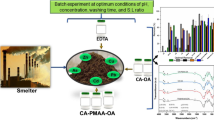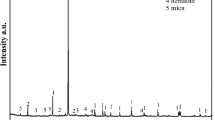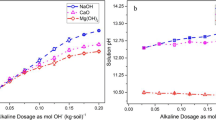Abstract
Soil leaching is a viable technology to achieve rapid remediation and reuse of contaminated sites. However, there is still a need to find leaching reagents that can achieve high removal rates of heavy metals with low environmental impact. Based on this, single and combined reagents were used to leach contaminated soil. In this study, three types of single leaching reagents, rhamnolipid, citric acid, and EDTA, were selected, and their leaching characteristics for cadmium (Cd) and mercury (Hg) were investigated. The effect of different factors on the elution rate was investigated by applying EDTA in combination with organic acids (citric acid, tartaric acid, and oxalic acid), and the operating parameters of EDTA-citric acid were optimized by using the response surface methodology. In addition, changes in the physicochemical properties of the soil before and after leaching, as well as the stability and mobility of heavy metals, were evaluated using IR and MF indices. The results showed that the mixture of 2% EDTA and 5% citric acid was the most effective for heavy metal removal. The optimum eluent parameters for S1 (light contamination level) were: EDTA/citric acid volume ratio:1:1, liquid/soil ratio:20:1, and leaching time:120 min; under these operating conditions, the Cd and Hg removal rates were 88.7% and 66.3%, respectively. The optimum eluent parameters for S2 (heavy contamination level) were: EDTA/citric acid volume ratio:1.5:1, liquid/soil ratio:30:1, and leaching time:120 min; under these operating conditions, the Cd and Hg removal rates were 91.2% and 71.5%, respectively. Both S1 and S2 could meet the soil standard after leaching with this composite reagent (Cd: 65 mg/kg; Hg: 38 mg/kg). In the risk assessment, the physicochemical properties of the soil did not change significantly after EDTA-organic acid leaching. The content of residual heavy metals in effective form was greatly reduced, and the stability was significantly improved, indicating that the composite leaching reagents could effectively reduce the ecological risk of contaminated soil. Therefore, combining EDTA with organic acids was an advisable method to improve soil leaching technology.













Similar content being viewed by others
References
Allman, A., Whiteside, J., Jewell, E., Griffiths, C., McMurray, N., & De Vooys, A. (2020). Surface modification of Cr(III) packaging substrates for enhanced adhesion via citric acid processing. Surfaces and Interfaces, 20, 100545. https://doi.org/10.1016/j.surfin.2020.100545
Amofah, L. R., Maurice, C., Kumpiene, J., & Bhattacharya, P. (2011). The influence of temperature, pH/molarity and extractant on the removal of arsenic, chromium and zinc from contaminated soil. Journal of Soils and Sediments, 11(8), 1334–1344. https://doi.org/10.1007/s11368-011-0411-y
Aşçı, Y., Nurbaş, M., & Açıkel, Y. S. (2007). Sorption of Cd(II) onto kaolin as a soil component and desorption of Cd(II) from kaolin using rhamnolipid biosurfactant. Journal of Hazardous Materials, 139(1), 50–56. https://doi.org/10.1016/j.jhazmat.2006.06.004
Ash, C., Tejnecký, V., Borůvka, L., & Drábek, O. (2016). Different low-molecular-mass organic acids specifically control leaching of arsenic and lead from contaminated soil. Journal of Contaminant Hydrology, 187, 18–30. https://doi.org/10.1016/j.jconhyd.2016.01.009
Beiyuan, J., Tsang, D. C. W., Valix, M., Baek, K., Ok, Y. S., Zhang, W., et al. (2018). Combined application of EDDS and EDTA for removal of potentially toxic elements under multiple soil washing schemes. Chemosphere, 205, 178–187. https://doi.org/10.1016/j.chemosphere.2018.04.081
Bucheli-Witschel, M., & Egli, T. (2001). Environmental fate and microbial degradation of aminopolycarboxylic acids. FEMS Microbiology Reviews, 25(1), 69–106. https://doi.org/10.1111/j.1574-6976.2001.tb00572.x
Cao, Y., Zhang, S., Zhong, Q., Wang, G., Xu, X., Li, T., et al. (2018). Feasibility of nanoscale zero-valent iron to enhance the removal efficiencies of heavy metals from polluted soils by organic acids. Ecotoxicology and Environmental Safety, 162, 464–473. https://doi.org/10.1016/j.ecoenv.2018.07.036
Chang, T., & Yen, J. (2006). On-site mercury-contaminated soils remediation by using thermal desorption technology. Journal of Hazardous Materials, 128(2–3), 208–217. https://doi.org/10.1016/j.jhazmat.2005.07.053
Chen, Y., Zhang, S., Xu, X., Yao, P., Li, T., Wang, G., et al. (2015). Effects of surfactants on low-molecular-weight organic acids to wash soil zinc. Environmental Science and Pollution Research, 23(5), 4629–4638. https://doi.org/10.1007/s11356-015-5700-3
Dermont, G., Bergeron, M., Mercier, G., & Richer-Laflèche, M. (2008). Soil washing for metal removal: A review of physical/chemical technologies and field applications. Journal of Hazardous Materials, 152(1), 1–31. https://doi.org/10.1016/j.jhazmat.2007.10.043
Finžgar, N., & Leštan, D. (2007). Multi-step leaching of Pb and Zn contaminated soils with EDTA. Chemosphere, 66(5), 824–832. https://doi.org/10.1016/j.chemosphere.2006.06.029
Gautam, P., Bajagain, R., & Jeong, S. W. (2020). Combined effects of soil particle size with washing time and soil-to-water ratio on removal of total petroleum hydrocarbon from fuel contaminated soil. Chemosphere, 250, 126206. https://doi.org/10.1016/j.chemosphere.2020.126206
Gee, G. W., & Bauder, J. W. (1986). Particle-size analysis. In A. Klute (Ed.), Methods of soil analysis (pp. 383–411). American Society of Agronomy/Soil Science Society of America.
Guo, X., Wei, Z., Wu, Q., Li, C., Qian, T., & Zheng, W. (2016). Effect of soil washing with only chelators or combining with ferric chloride on soil heavy metal removal and phytoavailability: Field experiments. Chemosphere, 147, 412–419. https://doi.org/10.1016/j.chemosphere.2015.12.087
Gusiatin, Z. M., & Klimiuk, E. (2012). Metal (Cu, Cd and Zn) removal and stabilization during multiple soil washing by saponin. Chemosphere, 86(4), 383–391. https://doi.org/10.1016/j.chemosphere.2011.10.027
Han, Y., Zhang, C., Zhu, L., Gao, Q., Wu, L., Zhang, Q., & Zhao, R. (2019). Effect of alternating electromagnetic field and ultrasonic on CaCO3 scale inhibitive performance of EDTMPS. Journal of the Taiwan Institute of Chemical Engineers, 99, 104–112. https://doi.org/10.1016/j.jtice.2019.03.008
Hu, B., Shao, S., Ni, H., Fu, Z., Hu, L., Zhou, Y., et al. (2020). Current status, spatial features, health risks, and potential driving factors of soil heavy metal pollution in China at province level. Environmental Pollution, 266, 114961. https://doi.org/10.1016/j.envpol.2020.114961
Hu, W., Niu, Y., Zhu, H., Dong, K., Wang, D., & Liu, F. (2021). Remediation of zinc-contaminated soils by using the two-step washing with citric acid and water-soluble chitosan. Chemosphere, 282, 131092. https://doi.org/10.1016/j.chemosphere.2021.131092
Huang, K., Shen, Y., Wang, X., Song, X., Yuan, W., Xie, J., et al. (2021a). Choline-based deep eutectic solvent combined with EDTA-2Na as novel soil washing agent for lead removal in contaminated soil. Chemosphere, 279, 130568. https://doi.org/10.1016/j.chemosphere.2021.130568
Huang, Q., Yu, Y., Zheng, J., Zhou, J., Wu, Z., Deng, H., et al. (2021b). Understanding and controlling the key phase transformation for selective extracting Ni and Cu from Cr-containing electroplating sludge. Surfaces and Interfaces, 24, 101090. https://doi.org/10.1016/j.surfin.2021.101090
Jiang, J., Yang, M., Gao, Y., Wang, J., Li, D., & Li, T. (2017). Removal of toxic metals from vanadium-contaminated soils using a washing method: Reagent selection and parameter optimization. Chemosphere, 180, 295–301. https://doi.org/10.1016/j.chemosphere.2017.03.116
Jiang, Y. F., Zhan, H. Y., Yuan, J. M., Ma, M. G., & Chen, H. (2006). Washing efficiency of heavy metals in soils with EDTA enhanced by surfactants. Journal of Agro-Environment Science, 25(1), 119–123.
Kandpal, G., Srivastava, P. C., & Ram, B. (2005). Kinetics of desorption of heavy metals from polluted soils: Influence of soil type and metal source. Water Air Soil Pollut, 161(1–4), 353–363. https://doi.org/10.1007/s11270-005-5548-0
Lee, C. S. L., Li, X., Shi, W., Cheung, S. C. N., & Thornton, I. (2006). Metal contamination in urban, suburban, and country park soils of Hong Kong: A study based on GIS and multivariate statistics. Science of The Total Environment, 356(1), 45–61. https://doi.org/10.1016/j.scitotenv.2005.03.024
Lee, D. H., Cody, R. D., Kim, D. J., & Choi, S. (2002). Effect of soil texture on surfactant-based remediation of hydrophobic organic-contaminated soil. Environment International, 27(8), 681–688. https://doi.org/10.1016/s0160-4120(01)00130-1
Li, L. I., Zhang, S., He, Q., & Hu, X. B. (2015b). Application of response surface methodology in experiment design and optimization. Research and exploration in laboratory, 34(8), 41–45.
Li, Y. J., Hu, P. J., Zhao, J., & Dong, C. X. (2015a). Remediation of cadmium- and lead-contaminated agricultural soil by composite washing with chlorides and citric acid. Environmental Science and Pollution Research, 22(7), 5563–5571. https://doi.org/10.1007/s11356-014-3720-z
Lian, M., Wang, L., Feng, Q., Niu, L., Zhao, Z., Wang, P., et al. (2021). Thiol-functionalized nano-silica for in-situ remediation of Pb, Cd, Cu contaminated soils and improving soil environment. Environmental Pollution, 280, 116879. https://doi.org/10.1016/j.envpol.2021.116879
Liu, C. C., & Lin, Y. C. (2013). Reclamation of copper-contaminated soil using EDTA or citric acid coupled with dissolved organic matter solution extracted from distillery sludge. Environmental Pollution, 178, 97–101. https://doi.org/10.1016/j.envpol.2013.02.034
Liu, Q., Deng, Y., Tang, J., Chen, D., Li, X., Lin, Q., et al. (2019). Potassium lignosulfonate as a washing agent for remediating lead and copper co-contaminated soils. Science of The Total Environment, 658, 836–842. https://doi.org/10.1016/j.scitotenv.2018.12.228
Mao, X., Jiang, R., Xiao, W., & Yu, J. (2015). Use of surfactants for the remediation of contaminated soils: A review. Journal of Hazardous Materials, 285, 419–435. https://doi.org/10.1016/j.jhazmat.2014.12.009
Mukhopadhyay, S., Mukherjee, S., Adnan, N. F., Hayyan, A., Hayyan, M., Hashim, M. A., & Gupta, B. S. (2016). Ammonium-based deep eutectic solvents as novel soil washing agent for lead removal. Chemical Engineering Journal, 294, 316–322. https://doi.org/10.1016/j.cej.2016.02.030
Mulligan, C. N. (2005). Environmental applications for biosurfactants. Environmental Pollution, 133(2), 183–198. https://doi.org/10.1016/j.envpol.2004.06.009
Mulligan, C. N., Yong, R. N., & Gibbs, B. F. (2001). Heavy metal removal from sediments by biosurfactants. Journal of Hazardous Materials, 85(1–2), 111–125. https://doi.org/10.1016/s0304-3894(01)00224-2
Navarro, A., Cañadas, I., Martinez, D., Rodriguez, J., & Mendoza, J. L. (2009). Application of solar thermal desorption to remediation of mercury-contaminated soils. Solar Energy, 83(8), 1405–1414. https://doi.org/10.1016/j.solener.2009.03.013
O’Connor, D., Hou, D., Ok, Y. S., Mulder, J., Duan, L., Wu, Q., et al. (2019). Mercury speciation, transformation, and transportation in soils, atmospheric flux, and implications for risk management: A critical review. Environment International, 126, 747–761. https://doi.org/10.1016/j.envint.2019.03.019
Qiu, R., Zou, Z., Zhao, Z., Zhang, W., Zhang, T., Dong, H., & Wei, X. (2010). Removal of trace and major metals by soil washing with Na2EDTA and oxalate. Journal of Soils and Sediments, 10(1), 45–53. https://doi.org/10.1007/s11368-009-0083-z
Samaksaman, U., Peng, T. H., Kuo, J. H., Lu, C. H., & Wey, M. Y. (2016). Thermal treatment of soil co-contaminated with lube oil and heavy metals in a low-temperature two-stage fluidized bed incinerator. Applied Thermal Engineering, 93, 131–138. https://doi.org/10.1016/j.applthermaleng.2015.09.024
Shen, F., Liao, R., Ali, A., Mahar, A., Guo, D., Li, R., et al. (2017). Spatial distribution and risk assessment of heavy metals in soil near a Pb/Zn smelter in Feng County, China. Ecotoxicology and Environmental Safety, 139, 254–262. https://doi.org/10.1016/j.ecoenv.2017.01.044
Sierra, M. J., Millán, R., López, F. A., Alguacil, F. J., & Cañadas, I. (2015). Sustainable remediation of mercury contaminated soils by thermal desorption. Environmental Science and Pollution Research, 23(5), 4898–4907. https://doi.org/10.1007/s11356-015-5688-8
Son, H. O., & Jung, M. C. (2010). Relative extraction ratio (RER) for arsenic and heavy metals in soils and tailings from various metal mines, Korea. Environmental geochemistry and health, 33(S1), 121–132. https://doi.org/10.1007/s10653-010-9356-0
Tang, J., He, J., Liu, T., & Xin, X. (2017). Removal of heavy metals with sequential sludge washing techniques using saponin: Optimization conditions, kinetics, removal effectiveness, binding intensity, mobility and mechanism. RSC advances, 7(53), 33385–33401. https://doi.org/10.1039/c7ra04284a
Wu, B., Guo, S., Zhang, M., Chen, C., & Zhang, Y. (2022). Coupling effects of combined thermal desorption and stabilisation on stability of cadmium in the soil. Environmental Pollution, 310, 119905. https://doi.org/10.1016/j.envpol.2022.119905
Xiao, R., Ali, A., Wang, P., Li, R., Tian, X., & Zhang, Z. (2019). Comparison of the feasibility of different washing solutions for combined soil washing and phytoremediation for the detoxification of cadmium (Cd) and zinc (Zn) in contaminated soil. Chemosphere, 230, 510–518. https://doi.org/10.1016/j.chemosphere.2019.05.121
Xiao, R., Wang, S., Li, R., Wang, J. J., & Zhang, Z. (2017). Soil heavy metal contamination and health risks associated with artisanal gold mining in Tongguan, Shaanxi, China. Ecotoxicology and Environmental Safety, 141, 17–24. https://doi.org/10.1016/j.ecoenv.2017.03.002
Yoo, J. C., Beiyuan, J., Wang, L., Tsang, D. C. W., Baek, K., Bolan, N. S., et al. (2018). A combination of ferric nitrate/EDDS-enhanced washing and sludge-derived biochar stabilization of metal-contaminated soils. Science of The Total Environment, 616–617, 572–582. https://doi.org/10.1016/j.scitotenv.2017.10.310
Yue, R., Zhang, X., Zhong, Y., Chen, Z., Zhao, Y., Wang, D., et al. (2022). Thermal reduction-desorption of cadmium from contaminated soil by a biomass co-pyrolysis process. Journal of Hazardous Materials, 423, 126937. https://doi.org/10.1016/j.jhazmat.2021.126937
Zaki, M. S., Zakaria, A., Eissa, I. A. E. M., & Eldeen, A. I. N. (2016). Effect of cadmium toxicity on Vertebrates. Electron physician, 8(2), 1964–1965. https://doi.org/10.19082/1964
Zhao, C., Dong, Y., Feng, Y., Li, Y., & Dong, Y. (2019). Thermal desorption for remediation of contaminated soil: A review. Chemosphere, 221, 841–855. https://doi.org/10.1016/j.chemosphere.2019.01.079
Zhu, Z., Wang, J., Liu, X., Yuan, L., Liu, X., & Deng, H. (2021). Comparative study on washing effects of different washing agents and conditions on heavy metal contaminated soil. Surfaces and Interfaces, 27, 101563. https://doi.org/10.1016/j.surfin.2021.101563
Hindersmann, I., & Mansfeldt, T. (2014). Trace element solubility in a multimetal-contaminated soil as affected by redox conditions. Water, Air, & Soil Pollution, 225(10). https://doi.org/10.1007/s11270-014-2158-8
Ministry of Ecology and Environment (2021). China ecological environment status bulletin. Central People’s Government of the People’s Republic of China website. https://www.mee.gov.cn/hjzl/sthjzk/zghjzkgb/202205/P020220608338202870777.pdf
Acknowledgements
We thank all study participants for their cooperation in this project.
Availability of Data and Materials
All data generated or analyzed during this study are included in this published article.
Funding
This work was supported by the National Basic Research Program of China (2019YFC180380202).
Author information
Authors and Affiliations
Contributions
All authors contributed to the study conception and design. Material preparation was performed by Jiaru Sun, Jie Qian, Tianci Huang, and Fei Su. Data collection and analysis were performed by Yinghua Li, Jiaru Sun, and Jie Qian. The first draft of the manuscript was written by Jiaru Sun. The previous versions of the manuscript were corrected by Yinghua Li. All authors read and approved the final manuscript.
Corresponding author
Ethics declarations
Ethical Approval and Consent to Participate
Not applicable
Consent for Publication
Not applicable
Competing Interests
The authors declare no competing interests.
Additional information
Publisher’s Note
Springer Nature remains neutral with regard to jurisdictional claims in published maps and institutional affiliations.
Rights and permissions
Springer Nature or its licensor (e.g. a society or other partner) holds exclusive rights to this article under a publishing agreement with the author(s) or other rightsholder(s); author self-archiving of the accepted manuscript version of this article is solely governed by the terms of such publishing agreement and applicable law.
About this article
Cite this article
Li, Y., Sun, J., Qian, J. et al. Study on the Remediation of Cadmium/Mercury Contaminated Soil by Leaching: Effectiveness, Conditions, and Ecological Risks. Water Air Soil Pollut 234, 45 (2023). https://doi.org/10.1007/s11270-023-06060-x
Received:
Accepted:
Published:
DOI: https://doi.org/10.1007/s11270-023-06060-x




